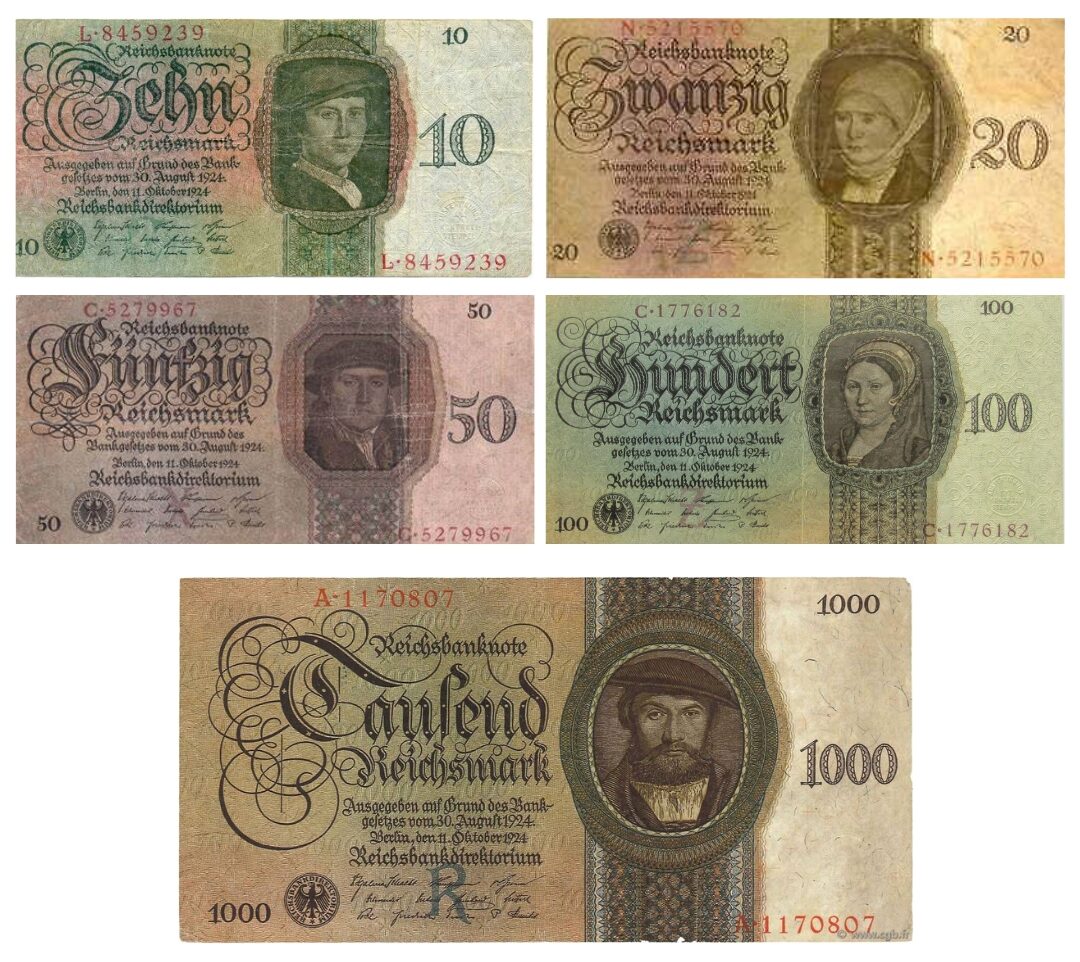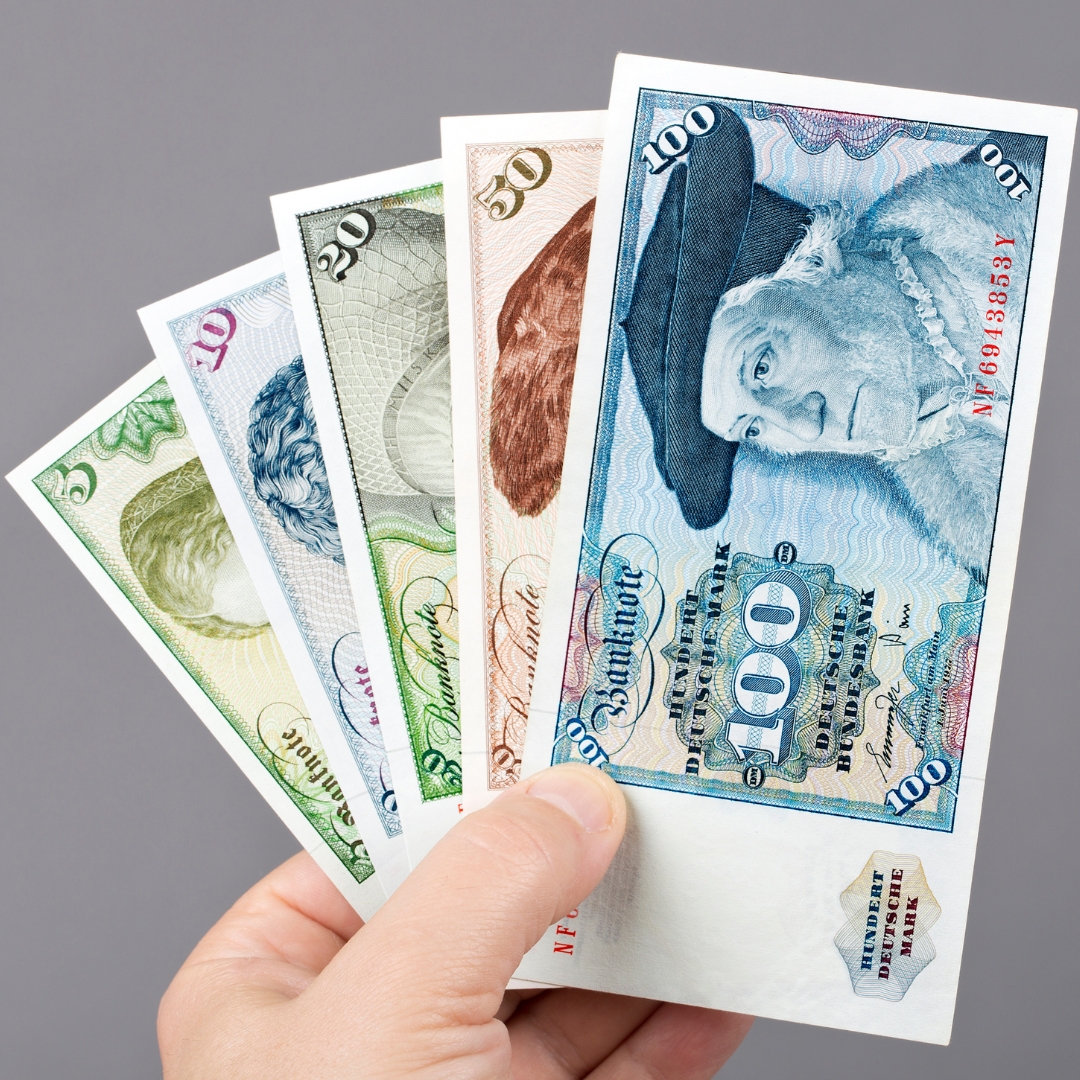Last updated on August 30th, 2024 at 01:13 pm
Last Updated on August 30, 2024 Posted by Colonial Acres Coins
Collecting banknotes and coins from around the world is a thrilling pursuit. Each piece carries a fragment of history, telling stories of empires, wars, and cultural shifts. If you’re really into European history, German paper money has some fascinating stories to tell.
In this blog post, we’ll explore the fascinating history of German currency. From the diverse marks that dotted Germany’s fragmented past to the unified euro, we’ll highlight key historical events and trends. By learning more about the world’s various currencies, you’ll discover numerous reasons to add German paper money to your collection.
The Roots of German Currency
German currency has a storied history that mirrors the nation’s complex and tumultuous journey. Before the unification of Germany, various regions and states issued their own forms of currency, reflecting the patchwork nature of the Germanic territories. This era saw a variety of Deutsche Marks and thalers (a German silver coin) that not only facilitated trade but also served as symbols of regional power and identity. As you explore the roots of German currency, you’ll uncover the intricate web of influences and events that shaped the financial landscape of one of Europe’s most influential countries.
Germany was not a unified country until 1871. Before that, it was a patchwork of principalities, each with its currency system. Prussia, Hanover, Saxony, and Bavaria were among the many regions issuing their own marks. This fragmented landscape made commerce and trade complex, but also created a fascinating array of banknotes and coins—each reflecting the values and artistry of its time. Collectors today can find pieces from these different principalities, each with its own unique design and history.
The Formation of the German Empire
The unification of Germany in 1871 under Otto von Bismarck marked a significant turning point. The new German Empire standardized its currency, issuing the gold mark. This new system facilitated easier trade and economic stability. The banknotes from this era often featured intricate designs and portraits of notable figures, reflecting the newfound pride in a unified Germany. Collectors prize these notes for their historical importance and aesthetic appeal.
Paper Money During the Monarchy
Before the monarchy was ousted in 1918, German paper money was relatively stable. The designs were elaborate, often featuring allegorical figures, coats of arms, and lush landscapes. These banknotes are a window into a time when Germany was establishing itself as a major European power. For collectors, these notes are valuable for their beauty and the stories they tell about Germany’s ambitions and values during this period.
The Turmoil of the Early 20th Century
The defeat in the First World War led to the ousting of the German monarchy in 1918. The
Weimar Republic that followed faced numerous challenges, the most significant being hyperinflation. During this period, the value of money plummeted, and the denominations of paper money reached astronomical figures. Banknotes from this era often had denominations in the millions and even billions. They serve as a poignant reminder of the economic turmoil and social upheaval that Germany experienced during these years.
The hyperinflation of the early 1920s is one of the most dramatic episodes in Germany’s economic history. People needed wheelbarrows full of banknotes just to buy basic necessities. This period produced some of the most unusual and interesting banknotes in the history of numismatics. Some notes were printed on cheaper materials like cloth or cardboard, given the scarcity of traditional paper. For collectors, these notes are fascinating artifacts of a time when the very concept of money was in flux.
- The Rise of the Reichsmark: In 1924, Germany introduced the Reichsmark to stabilize the economy. This new currency was more stable and helped to restore some economic order. The banknotes from this era reflect a transition from chaos to stability, featuring more conservative and reassuring designs. Collectors often seek out these notes as symbols of resilience and recove
glucotrol xl for sale online in the best USA pharmacy https://www.parschauer.com/wp-content/uploads/2025/10/html/glucotrol-xl-for-sale.html no prescription with fast delivery drugstore
ry in German history.

- The Impact of World War II: The defeat in the Second World War had profound effects on Germany, leading to its division into East and West. Each side issued its own currency, reflecting its distinct political ideologies. East Germany issued the East German Mark (Mark der DDR), while West Germany used the Deutsche Mark. The banknotes from this period are starkly different in design and symbolism, offering a fascinating study in contrasts. For collectors, these notes offer insights into the Cold War era and the ideological battle between East and West.
- East German Mark: The East German Mark featured utilitarian and socialist imagery, focusing on workers and industrial themes. These notes are less ornate but have a unique charm, reflecting the austere and functionalist principles of the socialist state. Collectors find these notes intriguing for their historical context and distinctive design.
- West German Deutsche Mark: In contrast, the West German Deutsche Mark featured more traditional and ornate designs, with images of historical figures, architecture, and cultural symbols. The Deutsche Mark became a symbol of West Germany’s economic miracle, representing stability and prosperity. Collectors value these notes for their beauty and the economic success story they symbolize.

Reunification and the Euro
The reunification of Germany in 1990 brought significant changes to its currency system. The Deutsche Mark became the official currency of a unified Germany. This period saw a resurgence of national pride, reflected in the design of the banknotes. Collectors often seek out these reunification-era notes for their historical significance and the sense of optimism they convey.
In 2002, Germany adopted the euro, joining other European Union countries in a unified currency system. The transition from the Deutsche Mark to the euro marked the end of a significant chapter in German currency history. The euro banknotes are standardized across member countries, but collectors still find value in the last series of Deutsche Mark notes as symbols of a bygone era.
Today, the euro serves as the official currency of Germany and many other EU countries. While it lacks the distinct national designs of earlier currencies, it represents a new era of European unity and cooperation. Collectors continue to find interest in the historical context and the evolution of German currency leading up to the euro.
The Appeal of German Paper Money
Collecting German paper money offers a unique way to engage with history. Each banknote tells a story, capturing moments of economic triumph and turmoil, political change, and cultural evolution. Whether it’s the hyperinflation banknotes of the Weimar Republic or the Deutsche Mark notes of the post-war economic miracle, each piece provides a tangible connection to Germany’s past.
German banknotes are renowned for their intricate designs and high-quality printing. From the ornate designs of the 19th century to the modern aesthetics of the Deutsche Mark, these notes are a joy to collect and display. The artistry involved in their creation makes them valuable not just as historical artifacts but also as works of art.
Embark on a Historic Journey: Collect German Paper Money with Colonial Acres Coins!
Collecting German paper money is more than just a hobby; it’s a journey through history. From the fragmented principalities of pre-1871 Germany to the unified Deutsche Mark and the modern euro, each note offers a window into the past. The variety of designs, historical significance, and investment potential make German banknotes a valuable addition to any collection.
At Colonial Acres Coins, we’re passionate about helping you build a collection that brings history to life. Our experts are here to guide you every step of the way, offering insights, appraisals, and a wide selection of rare and fascinating banknotes. Start your numismatic adventure with us today and explore the rich history of German paper money.




